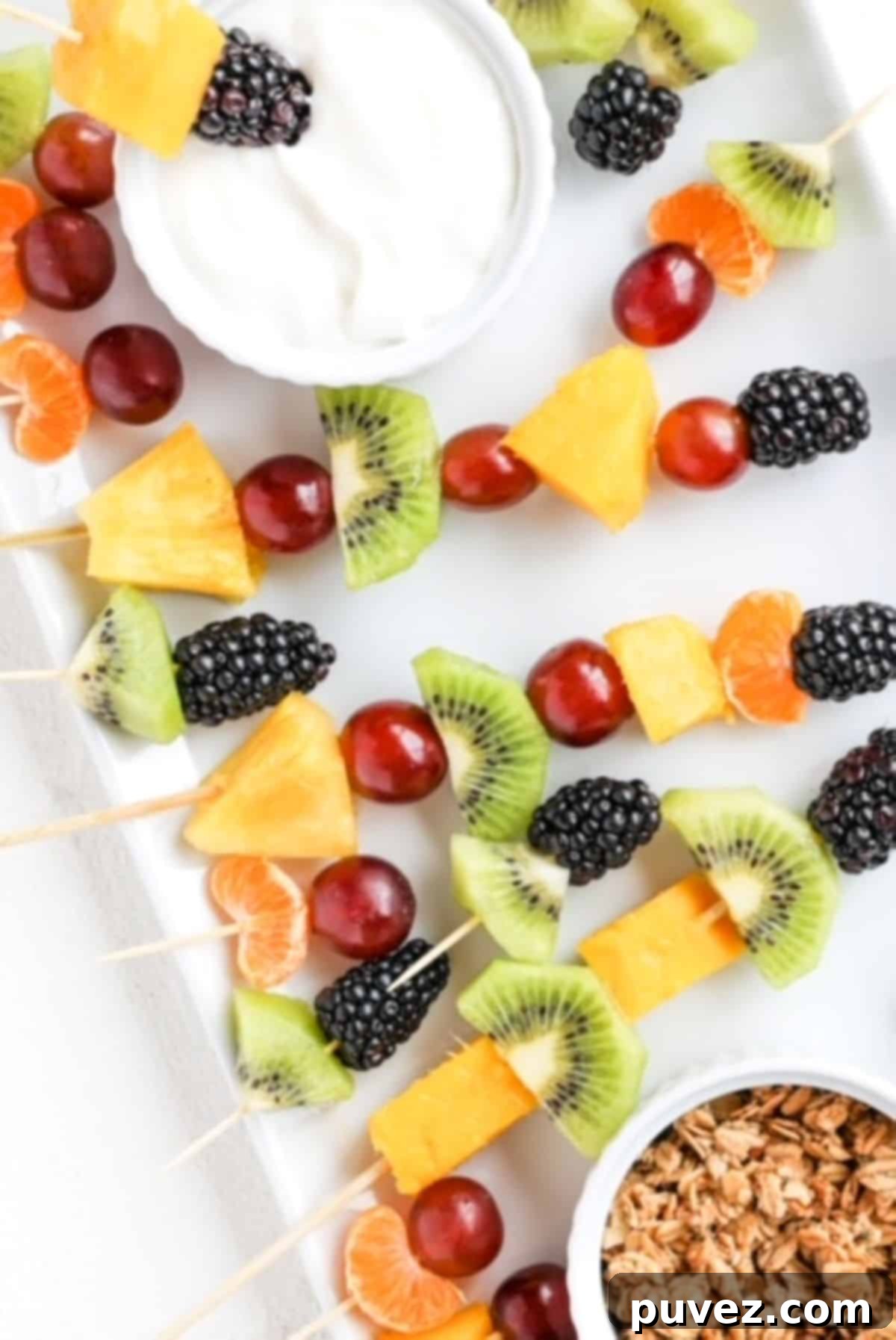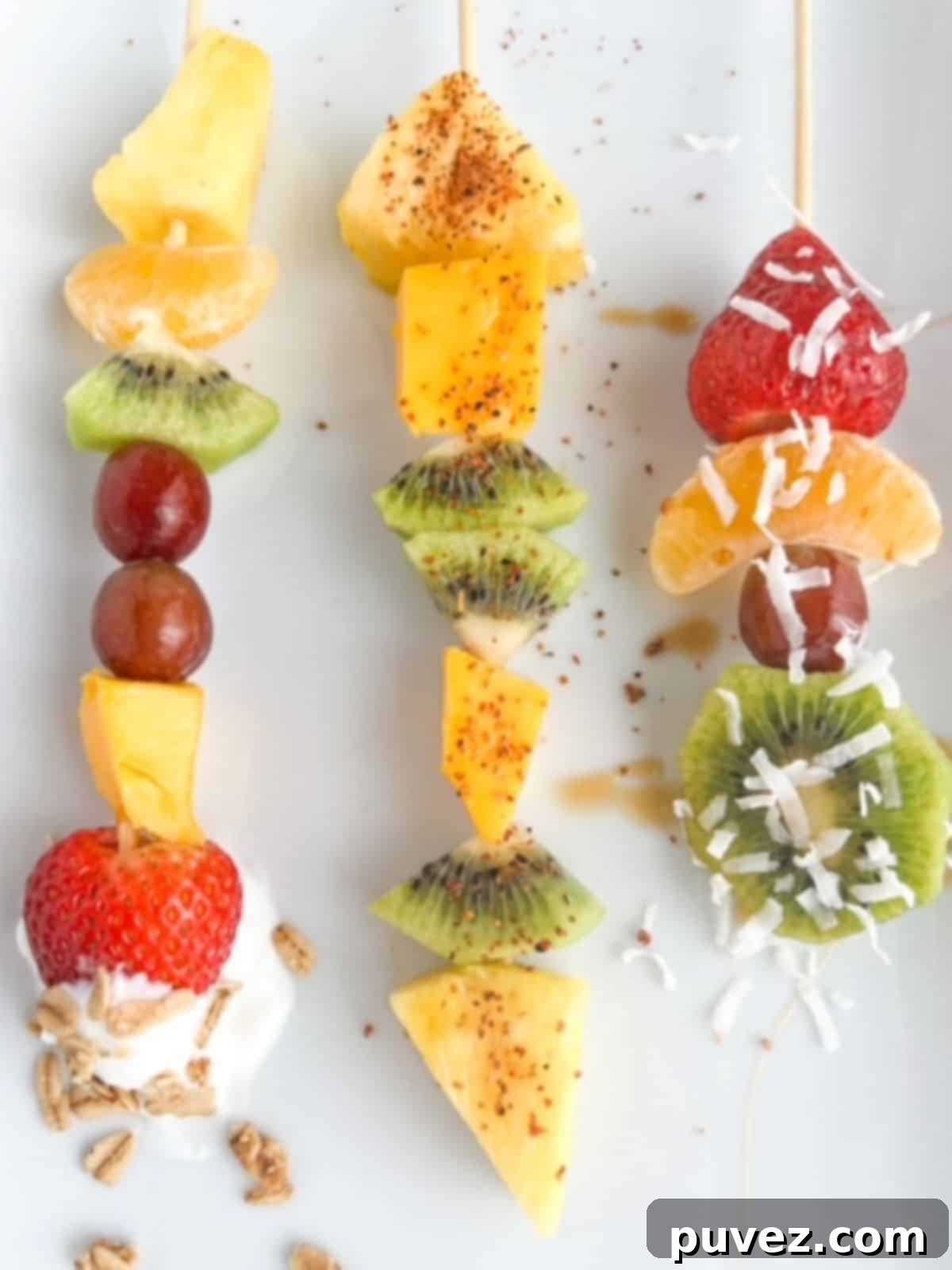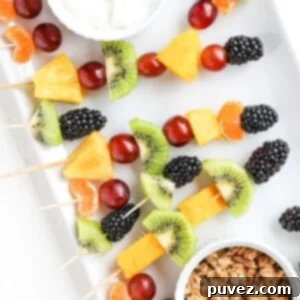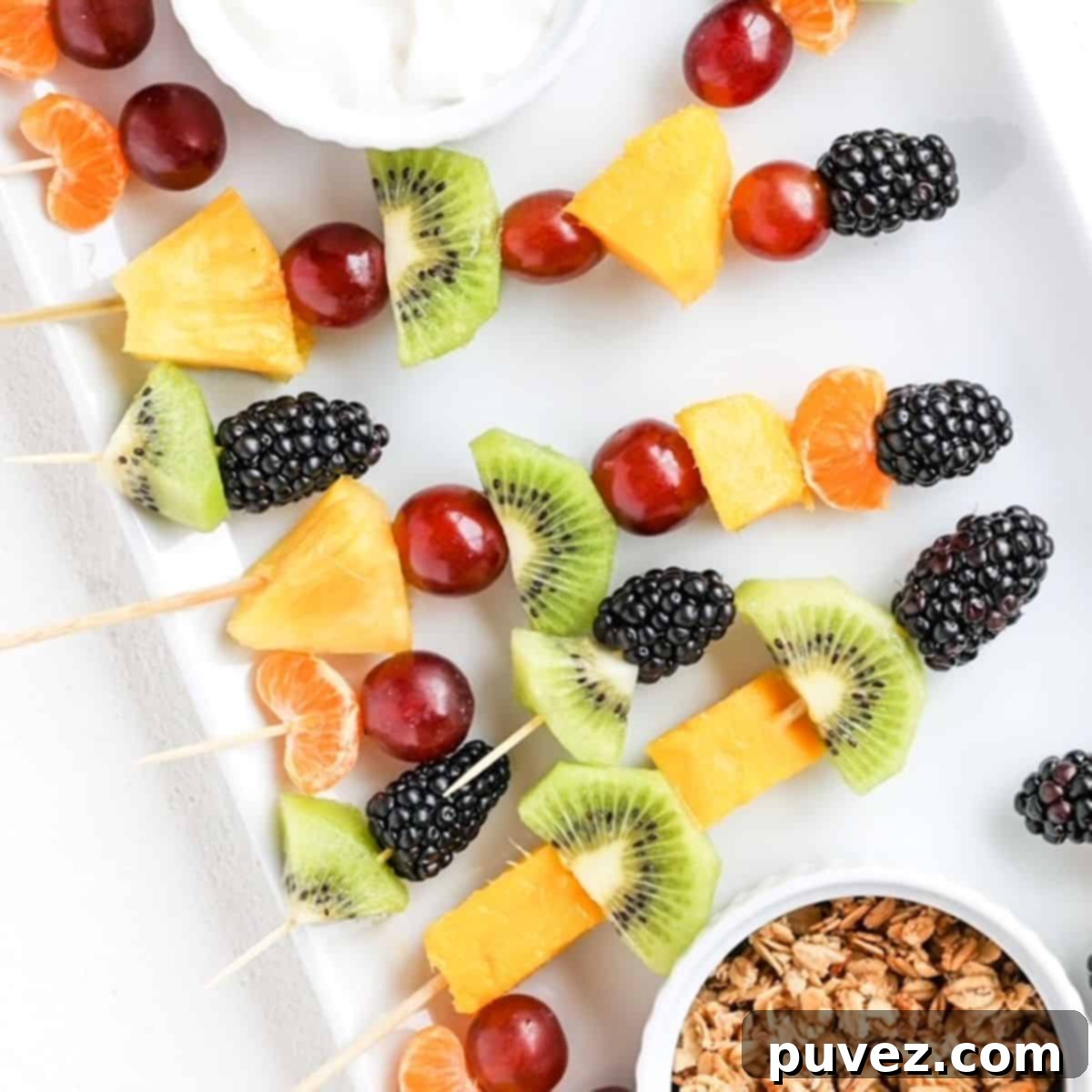Easy & Fun Fruit on a Stick: A Dietitian’s Guide to Healthy Kabobs Kids Love
Are you constantly searching for vibrant, healthy, and incredibly simple snack ideas that your children will genuinely adore? Look no further than **Fruit on a Stick**! This delightful concept, featuring fresh fruit served in an appetizer or kabob style, is championed by dietitians and quickly becomes a family favorite. As a dietitian and a mom, I intimately understand the daily quest to make nutritious eating appealing for kids. It often feels like a puzzle, especially when they come home from school with an insatiable appetite, even after classroom snacks.

Serving fruit **on a stick** (or even dipped in chocolate for an extra treat!) is an incredibly effective and enjoyable way to increase your children’s exposure to, acceptance of, and overall variety in the foods they eat. While having a fridge stocked with fresh fruit is a good first step, the real magic happens when you present it in a way that truly captures their attention and imagination. This simple act can transform an ordinary snack into an exciting culinary adventure.
I know it might sound surprisingly simple, but taking just a few extra moments to arrange colorful pieces of fruit on a toothpick or a longer bamboo kabob-style stick can make an immense difference. This playful presentation method not only makes fruit more appealing but also turns eating into a fun, interactive activity. Suddenly, those healthy servings become irresistible! After all, if I’m dedicating time to prepping and cutting up a bounty of fresh fruit, I absolutely want my kids to devour it with enthusiasm, right?
For those who follow my culinary adventures on Instagram, you’ll know that fresh fruit salad is a regular staple in our household, particularly during the bustling school year. However, even the most beloved dishes can become monotonous when served daily. That’s why I frequently change up how I present fruit. While a fruit salad might seem similar to fruit on a stick from an adult’s perspective, children perceive these presentations entirely differently. So, without further ado, let’s roll out the red carpet (or perhaps, the bamboo mat!) for fruit on a stick, exploring several creative and delicious ways to serve it, ensuring it never gets old.
Why You’ll Love This Easy Fruit Skewer Recipe
There are countless reasons why fruit on a stick will become a celebrated addition to your family’s snack and meal repertoire. Beyond its charming appearance, this simple recipe offers practical benefits for busy parents and growing kids alike.
- Effortlessly Easy: Fruit on a stick is genuinely simple to prepare and serve. Making food that kids enjoy doesn’t need to be complicated, and this recipe proves it. All you need to do is cut up fresh fruit into bite-sized pieces and thread them onto a stick. That’s it! Once assembled, these delightful sticks of fruit are incredibly versatile. They can be served as a refreshing, light snack on their own, or as a vibrant side dish to complement anything from quick breakfast sandwiches on hectic mornings to hearty turkey burgers for dinner. Their grab-and-go nature makes them ideal for lunchboxes, picnics, or after-school hunger pangs.
- No Baking or Cooking Required: In today’s fast-paced world, finding recipes that save time is a true victory. This recipe requires absolutely no baking, cooking, or elaborate preparation, making it a perfect solution for those moments when you need a quick, healthy option without heating up the kitchen. It’s a lifesaver on hot summer days or when you’re simply short on time.
- Packed with Fresh Fruit Goodness: At its core, this recipe celebrates the natural deliciousness of fresh fruit. Fruits are naturally sweet, making them highly appealing to children, and they are nutritional powerhouses. Beyond their enticing flavors, fruits provide essential fiber, a wide array of vitamins (like Vitamin C and A), vital minerals (such as potassium), and numerous other beneficial nutrients that support healthy growth and development. Eating a rainbow of fruits ensures a diverse intake of these crucial compounds.
- Naturally Allergy-Friendly: One of the most significant advantages of fresh fruit is its natural freedom from the eight most common food allergens. This makes fruit on a stick an excellent and safe choice for gatherings, school events, or for families managing various food sensitivities. It offers a worry-free, delicious option for almost everyone.
- Enthusiastically Kid-Approved: Kids are naturally drawn to the novelty and interactive element of eating food off a stick! This fun presentation transforms fruit from a mundane requirement into an exciting treat. It also allows children to clearly see and identify both their familiar favorite fruits and new varieties, subtly encouraging them to try new things in a non-pressured environment. The visual appeal and tactile experience make it a hit every time.
- Delightfully Family-Friendly: While undeniably a hit with the younger crowd, fruit kabobs are absolutely not just for kids! 😉 Adults will equally appreciate the freshness, convenience, and vibrant flavors. They make elegant additions to brunch spreads, barbecues, or as a light dessert. Everyone in the family can enjoy these colorful, refreshing skewers, making them a perfect shared snack or side.
Essential Tools & Ingredients for Fruit Skewers
Creating these appealing fruit skewers requires only a few basic items, most of which you likely already have on hand. The beauty of this recipe lies in its simplicity and adaptability.
- Sticks of Choice: You’ll need bamboo skewers (various lengths work well), regular toothpicks for smaller bites, or even lollipop sticks. Lollipop sticks are particularly great for younger children as they typically don’t have sharp ends, offering an extra layer of safety while still providing the “on a stick” fun factor. Consider the age of your children when choosing the type of stick.
- An Array of Fresh Fruit: This is where you can get creative and let seasonality guide you! I always recommend using a combination of fruits, adapting to whatever fresh options are readily available and in season. Excellent choices for threading onto sticks include firm berries like strawberries, blackberries, and raspberries, juicy mango chunks, vibrant kiwi slices, sweet pineapple pieces, plump grapes (seedless are best), easy-to-peel mandarin orange segments, and refreshing melon cubes (watermelon, cantaloupe, honeydew). The key is to choose fruits that hold their shape well and are easy to cut into uniform pieces.
- Quality Chef’s Knife: If you’ll be cutting your own fresh fruit from whole pieces, a sharp chef’s knife will make the task much easier and safer. Ensure it’s clean and sharp for precise cuts.
- Cutting Board: A sturdy cutting board is essential for safe and efficient fruit preparation.
- Colander: A colander is handy for rinsing berries and grapes thoroughly.
Dietitian Insights for Maximizing Fruit Consumption
It’s crucial to note that fruit on sticks should not be served to very young children, especially those under five, due to potential choking hazards and the sharp ends of skewers. However, for older kids, tweens, and teens who possess the fine motor skills to safely pull fruit off a stick and can sit down while eating, this snack or side dish made with fresh fruit is an absolute game-changer! Always supervise children while they enjoy this snack to ensure their safety.
Research consistently highlights that most children, and even adults, are not consuming enough fruits and vegetables. This alarming statistic underscores the importance of finding creative and appealing ways to incorporate these essential food groups into our diets. Serving fruits in engaging formats, like putting them on a stick, directly addresses this challenge by making healthy eating fun and irresistible for kids. The novelty and visual appeal can significantly increase their willingness to try and enjoy more fruit.
When assembling your fruit skewers, you have a few strategic options. You can either load them up with all of your kids’ current favorite fruits, ensuring an instant hit, or you can alternate familiar fruits with one or two that are new to them. This gentle exposure strategy, known as “food chaining” or “exposure therapy,” helps expand their palate without overwhelming them. Another fantastic approach is to serve the fruit kabobs with a delicious dipping companion, such as creamy yogurt or a homemade fruit dip. Dips add an element of fun and can introduce new flavors and textures, making the experience even more exciting.
While fruit kabobs are most often enjoyed as a refreshing snack, their versatility extends far beyond. They can seamlessly transition into a wholesome side dish for a variety of meals. Pair them with sandwiches or wraps for a balanced lunch, or serve them alongside almost any dinner. Their bright colors and fresh flavors can elevate any plate, adding crucial nutrients and a touch of vibrancy to family meals.
Simple Step-by-Step Instructions
Assembling fruit on a stick is incredibly straightforward. Follow these easy steps for perfectly prepared, irresistible fruit skewers:
- Prepare Berries and Grapes: Begin by thoroughly rinsing and draining any berries (strawberries, blackberries, raspberries) under cold running water. Similarly, wash your grapes well.
- Cut Melon: If using, cut your chosen melon (watermelon, cantaloupe, or honeydew) into uniform, bite-sized cubes or other fun shapes.
- Peel and Segment Clementines: Carefully peel your clementines (or mandarin oranges) and gently separate the individual segments.
- Slice Kiwi and Pineapple: Peel and slice kiwi into rounds, then halve each round. Cut pineapple rings into chunks or triangular segments, ensuring they are not too large.
- Thread the Fruit: Take one piece of prepared fruit at a time and carefully thread it onto your chosen stick. Alternate colors and textures for visual appeal.
- Leave Holding Space: Ensure you leave enough empty space at one end of each stick, typically about 1-2 inches, so that it can be comfortably held without touching the fruit.
- Arrange and Serve: Once all skewers are assembled, arrange them attractively on a platter and serve immediately, or prepare for later (see tips below for making ahead).
Creative Ways to Serve Fruit Skewers
The versatility of fruit on a stick truly shines when you explore different serving options. Here are some fantastic ideas to keep things exciting and delicious:

- Simply “As Is”: Often, the purest form is the best. Fruit on a stick can be served exactly ‘as is.’ The visual appeal and interactive nature are usually enough to entice eager eaters. My experience tells me your kids will likely be clamoring for a fruit skewer even before you’ve finished assembling the entire batch. It’s a refreshing, hydrating, and naturally sweet treat that needs no embellishment.
- With Yogurt and Granola: Elevate the experience by offering a side of creamy yogurt and crunchy granola. Kids can dip a piece of fruit from their toothpick into the yogurt, then roll it in the granola for a delightful textural combination. It’s like a deconstructed, mini fruit and yogurt parfait, offering a balanced snack with protein, healthy fats, and complex carbohydrates. Yum!
- Drizzled with Honey and Shredded Coconut: This idea, which I picked up from a catering event at work, is simply divine. Drizzle your fruit skewers with a touch of golden honey and sprinkle them generously with unsweetened shredded coconut. The honey adds an extra layer of sweetness and a lovely sheen, while the coconut provides a tropical flavor and satisfying chewiness. This makes for a more gourmet-style fruit presentation, perfect for special occasions or when you want to treat your family to something a little extra special.
- Spiced with Tajin: For those with more adventurous palates, a sprinkle of Tajin is a must-try. Tajin is a beloved chili-lime seasoning from Mexico that offers a unique tangy and mildly spicy kick. It pairs exceptionally well with tropical fruits such as juicy mango, sweet pineapple, ripe papaya, and refreshing watermelon. Simply sprinkle it on the fruit just before serving. Fun fact: I first discovered the magic of Tajin with fresh mango during a trip to Costa Rica, and it’s been a staple in my kitchen ever since!
- Tajin and Fresh Lime: To further enhance the bright flavors, add a generous drizzle of freshly squeezed lime juice in addition to the Tajin seasoning. The zesty lime juice amplifies the citrus notes in the Tajin and brings out the natural sweetness and tang of the fruit, creating an incredibly refreshing and complex flavor profile that’s perfect for a sunny day or as a vibrant palate cleanser.
Pro Tips for Perfect Fruit Skewers
To ensure your fruit on a stick experience is always a success, keep these helpful tips in mind:
- Varying Preparation Time: The total time it takes you to make these fruit skewers will largely depend on the types of fruit you choose and whether you opt to cut your own melon and pineapple or purchase them pre-cut from the grocery store. Buying pre-cut fruit will save significant time but often comes at a higher cost.
- Beware of Browning Fruits: Certain fruits, like bananas, pears, and apples, oxidize and brown very quickly once exposed to air. If you plan to include these in your skewers, it’s best to cut them just before you assemble and serve the kabobs to maintain their fresh appearance and texture. A splash of lemon juice can also help, but immediate serving is best.
- Consider the Stick Length for Dipping: Fruit placed on shorter toothpicks is generally much easier for dipping into yogurt or other sauces compared to fruit on longer, full-sized skewers. Keep this in mind if you plan to offer dips.
- Safety First for Young Children: Reiterating an important point: **Do not serve fruit on a stick to very young children.** The small pieces of fruit, combined with the stick itself, can pose a choking hazard.
- Sharp Ends Awareness: The ends of traditional toothpicks and bamboo skewers can be quite sharp. For safety, only serve fruit on sticks to older children who are fully capable of sitting down while eating and can handle these items in a safe and responsible manner. Always supervise children during snack time.
- Check for Splinters: Before you begin threading fruit, always take a moment to inspect your bamboo skewers or toothpicks for any potential splinters. This simple check ensures a safe and enjoyable eating experience.
Frequently Asked Questions About Fruit on a Stick
This delightful snack goes by many names! Common terms include fruit kabobs, fruit skewers, fruit sticks, or even fruit wands. The variety of names can sometimes be a little confusing, which is precisely why I prefer to keep it simple and call it ‘fruit on a stick’ – it’s clear, direct, and perfectly describes what it is! No matter what you call them, they’re a universally loved way to enjoy fruit.
Absolutely, you can! Preparing fruit skewers in advance is a fantastic time-saver, especially for parties or busy weeknights. Depending on the types of fruit you use, they can typically be made up to 24 hours in advance. To keep them fresh and vibrant, store them in the refrigerator within a resealable, food-safe plastic bag or an airtight container. If your skewers include fruits prone to browning, such as banana slices, pears, or apples, it’s best to wait until just before serving to add those specific fruits to the sticks, or lightly toss them in a bit of lemon juice to slow down oxidation.
Several fruits hold up beautifully when cut ahead of time, making your prep work even faster. Cantaloupe, honeydew melon, watermelon, and pineapple are all excellent choices that can be cut the night before and stored in an airtight container in the refrigerator without significant loss of quality or appearance. Grapes can also be washed ahead of time, but it’s generally recommended not to cut them until just before you’re ready to put them on a stick, as cutting can make them release juices and soften.
Using frozen fruit for kabobs can be a bit tricky, and success depends largely on the specific fruit. Frozen mango chunks often work quite well once thawed slightly, maintaining enough structure to be threaded. Frozen pineapple pieces are usually smaller and might become too soft upon defrosting, making them difficult to keep on a stick. The main challenge is that many fruits tend to soften significantly when they defrost, which can make it hard for the pieces to stay securely on a skewer. It’s generally recommended to use fresh fruit for the best texture and appearance, but feel free to experiment with firmer frozen options if you’re feeling adventurous!
More Fresh & Fruity Recipes to Explore
If you loved making these fruit skewers, here are more delicious and healthy fruit-centric recipes from my kitchen you might enjoy:
- Easy Fruit and Yogurt Parfait: Layers of creamy yogurt, fresh fruit, and crunchy granola for a wholesome breakfast or snack.
- Watermelon with Tajin: A simple yet incredibly flavorful snack, perfect for a spicy-sweet kick.
- Vibrant Fresh Fruit Salad: A classic blend of seasonal fruits, perfect for any occasion.
- Decadent Chocolate Dipped Pineapple: A sweet and indulgent treat that combines fruit with rich chocolate.
- Festive Thanksgiving Fruit Salad: A unique fruit salad tailored for holiday gatherings, featuring autumnal flavors.
Discover More Easy & Healthy Snack Recipes
Looking for even more simple and delicious snack ideas for your family? Here are a few more favorites that are quick to prepare and sure to please:
- Best Gingerbread Muffins Recipe
- Easy Deviled Eggs Without Mustard
- How to Make Steamed Hard-Boiled Eggs
- Peanut Butter Banana Oatmeal Smoothie
How did your family enjoy serving fruit on a stick? Please consider sharing this post with a friend who might also benefit from these healthy snack ideas, and don’t hesitate to leave a comment below to let me know your thoughts! A 5-star rating is always the best compliment!
Don’t forget to tag me @carrots.and.cookies on Instagram if you post a pic of your colorful fruit display so I can see your creative work!
📖 Recipe

Favorite Fruit on a Stick
Kristi
Pin Recipe
Equipment
-
6 bamboo skewers or you can use 12 toothpicks or 6 lollipop sticks, depending on desired size and safety for age group.
-
1 chef’s knife for preparing fresh fruit.
-
1 colander for rinsing berries and grapes.
-
1 Cutting Board for safe fruit preparation.
Ingredients
- 6 berries (e.g., blackberries, strawberries, or raspberries). Rinse well under cold water and set aside.
- 12 grapes (seedless variety recommended). Washed thoroughly.
- 1 clementine (seedless and easy to peel; can also substitute with easy-to-peel, seedless mandarins).
- 2 pineapple rings (cut into bite-sized chunks or triangle-shaped segments).
- 2 kiwi (peeled and sliced, then halve each slice).
- ½ mango (peeled and cut into substantial chunks).
- Optional serving suggestions: Greek yogurt, granola, honey, shredded coconut, or Tajin seasoning.
Instructions
-
Thoroughly wash and prepare all fruits. Peel and cut pineapple and mango into bite-sized chunks.
-
Peel clementines and carefully separate them into individual segments. Wash grapes thoroughly.
-
Peel the kiwi, then slice it into rounds. Cut each kiwi slice in half to make crescent shapes.
-
Carefully place 5-7 pieces of your prepared fruit onto each bamboo skewer, alternating colors and types for visual appeal. If using toothpicks, place 2-3 pieces of fruit on each. Ensure a portion of the stick remains free for easy handling.
-
Arrange the fruit skewers on a platter and serve immediately, perhaps with optional dips or toppings. Enjoy your healthy and fun snack!
Notes
- **Important Safety Note:** Do not serve fruit on a stick to very young children (typically under 5 years old) due to potential choking hazards and sharp stick ends.
- The ends of toothpicks and bamboo skewers are sharp. Only serve fruit on sticks to older children who are able to sit down to eat and are capable of eating these in a safe and supervised manner.
- The fruits listed above provide an excellent starting point for what works well on fruit skewers, offering a good balance of firmness and flavor.
- Chunks of watermelon, cantaloupe, and honeydew melon are also fantastic options for fruit skewers and can be easily used in place of, or in addition to, any of the fruits listed.
- Always make sure there aren’t any splinters in the bamboo skewers or toothpicks before placing fruit on them to ensure a safe eating experience.
- Prep time will vary depending on how much of the fruit you need to cut from whole pieces before assembly. Pre-cut fruit can significantly reduce prep time.
- Apples, bananas, and pears brown easily once they are cut and exposed to air. If you plan to use these fruits, it’s best to wait until just before serving to cut them into pieces and add them to the sticks, or toss them lightly in lemon juice.
- Buying pre-cut fruit from your grocery store will certainly cost more than buying whole fruit, but it offers a convenient shortcut and can save you a lot of time in preparation.
- Refer back to the main article for a few different, creative, and delicious ways to serve your fruit on a stick, making snack time more exciting!
- Fruit threaded onto a shorter toothpick is generally easier to dip into yogurt or other sauces compared to fruit on a longer skewer.
Nutrition
Tried this recipe?Let us know how it was!
